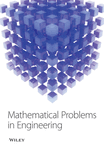Numerical Approximation of Nonlinear Klein-Gordon Equation Using an Element-Free Approach
Abstract
Numerical approximation of nonlinear Klein-Gordon (KG) equation with quadratic and cubic nonlinearity is performed using the element-free improved moving least squares Ritz (IMLS-Ritz) method. A regular arrangement of nodes is employed in this study for the numerical integration to compute the system equation. A functional formulation for the KG equation is established and discretized by the Ritz minimization procedure. Newmark’s integration scheme combined with an iterative technique is applied to the resulting nonlinear system equations. The effectiveness and efficiency of the IMLS-Ritz method for the KG equation have been testified through convergence analyses and comparison study between the present results and the exact solutions.
1. Introduction
The Klein-Gordon (KG) equation is essentially a relativistic version of the Schrödinger equation. It has wide applications in many scientific fields, such as quantum mechanics, solid state physics, and nonlinear optics [1]. Similar to the Schrödinger equation, the KG equation is considered as one of the important equations in mathematical physics, as well as kinds of solitons studies, especially in the investigation of solitons interactions for a collisionless plasma and the recurrence of initial states [2, 3].
As a kind of essential nonlinear PDEs, the KG type equations have received considerable attention in deriving both analytical and numerical solutions by using different types of methods, such as the Adomian decomposition method [3, 4], the sine-cosine ansatz and the tanh methods [2, 5, 6], the auxiliary equation method, the Weierstrass elliptic function method, the elliptic equation rational expansion method, and the extended F-function method [7–9]. In the process, various numerical schemes have also been developed based on different theories, such as the homotopy method [10], the cubic B-spline collocation method on a uniform mesh [11], and the approximation with thin plate splines (TPS) radial basis functions (RBF) based collocation approach [12].
To seek for an effective and efficient numerical technique, the meshless method has been successfully developed to solve partial differential equations that used to describe many physical and engineering problems. The advantages of these meshless methods are as follows: (i) solutions can be obtained with only a minimum of meshing or no meshing at all [13–18]; (ii) a set of scattered nodes is used instead of meshing the entire domain of the problem. Several meshless methods have been proposed and can be chosen as an alternative to search for approximate solutions of the KG equations [19, 20]. Based on different approximation functions, various meshless methods were proposed, such as the element-free Galerkin (EFG) method [21], the moving least squares differential quadrature method [22], the radial point interpolation method [23], the smooth particle hydrodynamics methods [24], the radial basis function [25], the element-free kp-Ritz method [26–30], the meshless local Petrov-Galerkin method [31], the reproducing kernel particle method [32], and the local Krigging method [33].
In this study, by combining the IMLS approximation and the Ritz procedure, the element-free IMLS-Ritz method for numerical solution of the nonlinear KG equation is presented. The cubic spline weight function and linear basis are employed in this study. A regular arrangement of nodes is employed for numerical integration to compute the system equation. A functional formulation for the KG equation is established and discretized by the Ritz procedure. The essential boundary conditions are imposed by the penalty method. Newmark’s integration scheme is employed to solve the nonlinear system equations. The applicability of the IMLS-Ritz method is examined on a few selected example problems. The accuracy of the presented method is also investigated by comparing the obtained numerical results with the existing analytical solutions.
2. Theoretical Formulation
2.1. Equivalent Functional of the One-Dimensional Nonlinear KG Equation
2.2. Improved Moving Least Squares Shape Functions
The abovementioned formulation details an IMLS approximation in which coefficients ai(x) are obtained directly. It is, therefore, avoiding forming an ill-conditioned or singular equation system.
When the weighted orthogonal basis functions in (20) and (21) are used, there exist fewer coefficients in the trial function.
3. The Ritz Minimization Procedure and Discretion Implementation
By solving the above iteration equations, we can obtain numerical solutions to the one-dimensional nonlinear Klein-Gordon equation.
4. Numerical Results and Discussion
4.1. Example 1
Consider the KG equation (1) with quadratic nonlinearity (k = 2), by taking the parameters α = −1, β = 0, γ = 1, and f(x, t) = −xcost + x2cos2t.
In the present example, the numerical solutions are obtained as the penalty factor α = 103 and dmax = 3. We examine the convergence of the element-free IMLS-Ritz method by varying the number of nodes (N) from 11 to 201. The L2-norm and L∞ errors of u(x, t) with CPU times are computed at t = 10 with Δt = 0.1 and tabulated in Table 1. We found that both L2-norm and L∞ errors arise as N increases. This may be due to that once convergent result has been obtained, in this case on N = 11, the additional arranged nodes will cause errors being accumulated. Based on this observation, the following analysis will be performed using N = 11 for accuracy consideration. We also investigated the influence of dmax on the accuracy of the IMLS-Ritz method. As illustrated in Table 2, by varying dmax from 2 to 3, accurate results can be furnished when dmax = 2. Furthermore, the predicted results are compared with the available exact solutions at t = 10 and illustrated in Figure 1. It is apparent that a close agreement is obtained from the illustrated results. The computed results of u(x, t) for a time history are also predicted between t = 0 s and t = 10 s (Δt = 0.1) (see Figure 2(a)). The corresponding absolute error contour is plotted in Figure 2(b). From the presented results, we can conclude that the approximate solutions generated by the IMLS-Ritz method agree well with the analytical results.
| N | L2-norm error | L∞ error | CPU time (s) |
|---|---|---|---|
| 11 | 4.7172 × 10−4 | 2.0891 × 10−4 | 1.5224 |
| 21 | 6.6446 × 10−4 | 2.1335 × 10−4 | 1.7486 |
| 51 | 1.0503 × 10−3 | 2.1488 × 10−4 | 5.2065 |
| 101 | 1.5343 × 10−3 | 2.1500 × 10−4 | 10.3477 |
| 201 | 2.1912 × 10−3 | 2.1504 × 10−4 | 19.8889 |
| 251 | 2.3485 × 10−3 | 2.1505 × 10−4 | 25.6620 |
| dmax | L2-norm error | L∞ error | CPU time (s) |
|---|---|---|---|
| 2 | 6.7304 × 10−4 | 2.1170 × 10−4 | 1.7510 |
| 2.2 | 6.9125 × 10−4 | 2.1913 × 10−4 | 1.7888 |
| 2.4 | 7.1843 × 10−4 | 2.2411 × 10−4 | 1.8604 |
| 2.6 | 6.5686 × 10−4 | 2.2234 × 10−4 | 1.7744 |
| 2.8 | 6.4655 × 10−4 | 2.1186 × 10−4 | 1.7812 |
| 3 | 6.6445 × 10−4 | 2.1335 × 10−4 | 1.7949 |
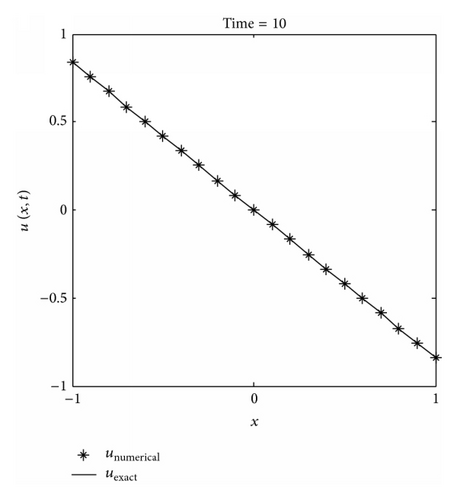
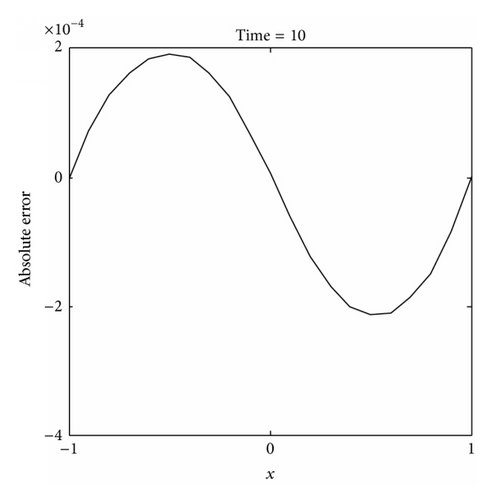
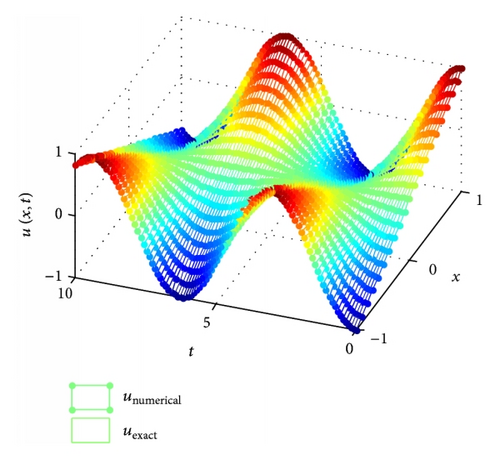
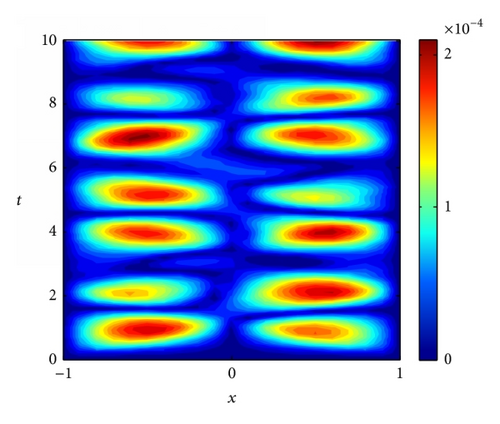
4.2. Example 2
In this analysis, numerical solutions are predicted and compared with the analytical solutions at t = 1, Δt = 0.01, dmax = 2.2, and the penalty factor λ = 103. Table 3 presents the convergence patterns of the IMLS-Ritz results by varying N from 6 to 101. A similar convergence trend is observed in Example 1; that is, convergent results can be obtained from N = 6 to 21; then, the errors are accumulated as N increases. Table 4 illustrates the values of L2-norm and L∞ errors as dmax varying from 2 to 3.5. A growing trend of L2-norm and L∞ errors is observed from Table 4, and the CPU time rises oscillatory as dmax increases. As presented in Figure 3, the comparison study shows that the IMLS-Ritz method provides very similar solutions to the exact results. In Figure 4, the absolute errors of u(x, t) at a selected time point (t = 1) and the absolute error contour on a time period (0 ≤ t ≤ 1) are exhibited at N = 21. Figure 5 is plotted at N = 101 for comparison with Figure 4. Although the increase in number of nodes has been identified to be unaided in enhancing the accuracy of the approximation, it influences the smoothness of the solutions indeed.
| N | L2-norm error | L∞ error | CPU time (s) |
|---|---|---|---|
| 6 | 2.1937 × 10−2 | 1.7231 × 10−2 | 0.1081 |
| 21 | 3.3745 × 10−4 | 2.0891 × 10−4 | 0.2683 |
| 26 | 3.7023 × 10−4 | 1.6600 × 10−4 | 0.3275 |
| 51 | 5.1750 × 10−4 | 1.6589 × 10−4 | 0.6268 |
| 101 | 7.2991 × 10−4 | 1.6588 × 10−4 | 1.1983 |
| dmax | L2-norm error | L∞ error | CPU time (s) |
|---|---|---|---|
| 2 | 3.3081 × 10−4 | 2.1170 × 10−4 | 0.2637 |
| 2.2 | 3.3746 × 10−4 | 1.6616 × 10−4 | 0.2644 |
| 2.4 | 3.4597 × 10−4 | 1.6866 × 10−4 | 0.2754 |
| 2.6 | 3.7193 × 10−4 | 1.7459 × 10−4 | 0.2690 |
| 2.8 | 3.8596 × 10−4 | 1.8276 × 10−4 | 0.2686 |
| 3 | 3.8960 × 10−4 | 1.9179 × 10−4 | 0.2650 |
| 3.2 | 4.2300 × 10−4 | 1.999 × 10−4 | 0.2644 |
| 3.5 | 4.9035 × 10−4 | 2.3717 × 10−4 | 0.2819 |
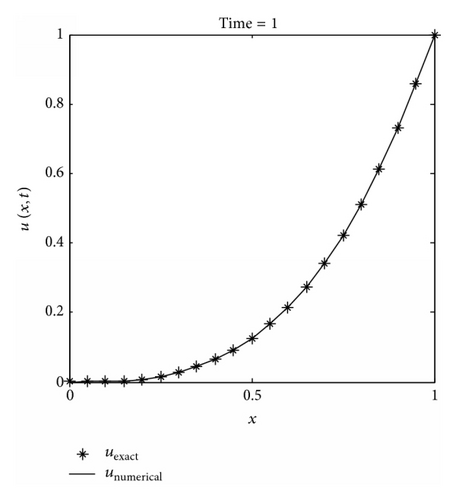
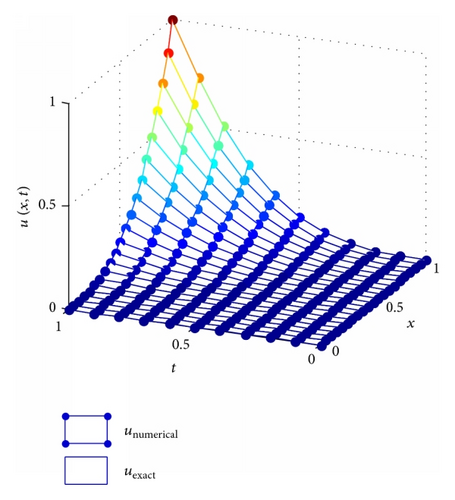
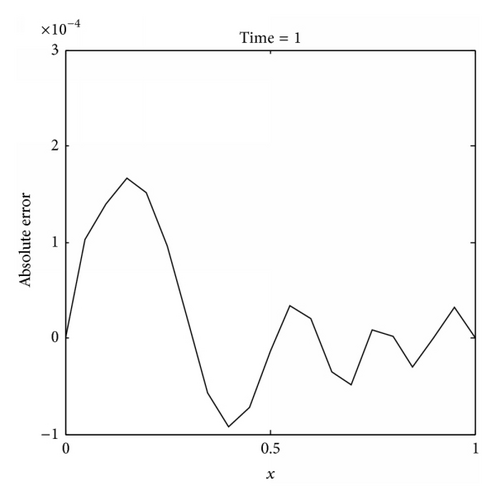
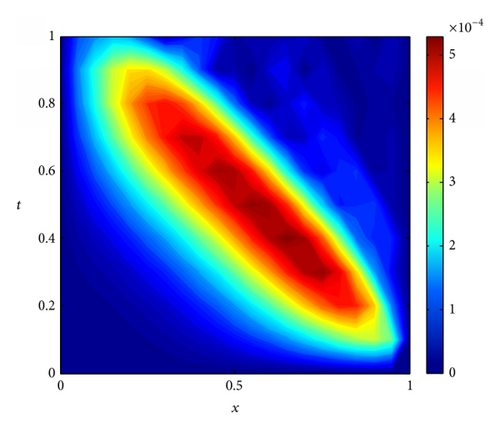
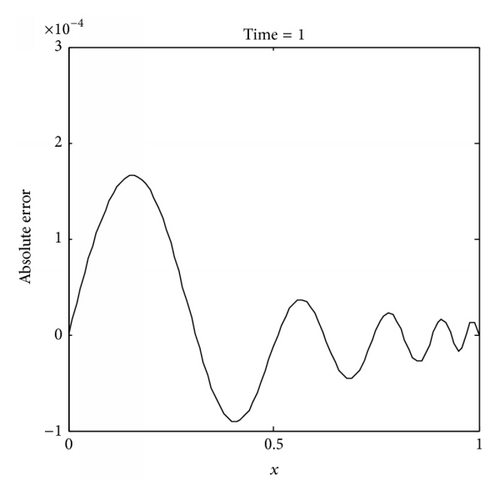
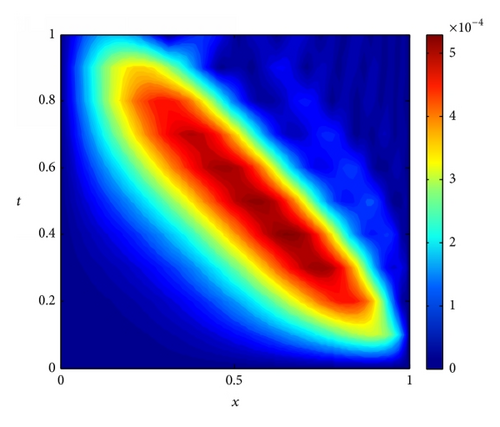
4.3. Example 3
The IMLS-Ritz computation is carried out by setting Δt = 0.1, the penalty factor λ = 103, and dmax = 2.5. The L2-norm and L∞ errors of u are computed with the number of nodes varied from 13 to 201. The results are tabulated in Table 5. It is apparent that both L2-norm and L∞ errors decrease as N increases, indicating that convergent results are obtained by the IMLS-Ritz method. From Table 6, the results of numerical analysis suggested that satisfied accuracy can be achieved when dmax = 2. In Figure 6, the numerical and analytical solutions are plotted on a time point (t = 2) and a time period (0 ≤ t ≤ 2). From the comparison results, we can conclude that the IMLS-Ritz method provides very similar solutions to the exact results. In Figures 7 and 8, the absolute errors of u(x, t) at a selected time point (t = 2) and the absolute error contour on a time period (0 ≤ t ≤ 1) are depicted at N = 21 and N = 201, respectively. As expected, more accurate results can be obtained as N increases in this example. From the results presented in both tables and figures, it is evident that the IMLS-Ritz values almost coincide with the exact solutions.
| N | L2-norm error | L∞ error | CPU time (s) |
|---|---|---|---|
| 13 | 1.9791 × 10−5 | 1.3049 × 10−5 | 447.3713 |
| 21 | 9.5355 × 10−6 | 5.7505 × 10−6 | 559.7717 |
| 51 | 2.8692 × 10−6 | 1.7171 × 10−6 | 600.6953 |
| 101 | 1.8512 × 10−6 | 1.3635 × 10−6 | 650.4551 |
| 126 | 1.4819 × 10−6 | 1.0907 × 10−6 | 687.4458 |
| 201 | 7.8596 × 10−7 | 5.3053 × 10−7 | 721.8184 |
| dmax | L2-norm error | L∞ error | CPU time (s) |
|---|---|---|---|
| 2 | 5.5466 × 10−6 | 3.4260 × 10−6 | 793.1491 |
| 2.2 | 1.8244 × 10−5 | 1.0416 × 10−5 | 826.7344 |
| 2.4 | 3.2447 × 10−5 | 1.8490 × 10−5 | 891.1543 |
| 2.6 | 4.5397 × 10−5 | 2.5715 × 10−5 | 945.6493 |
| 2.8 | 4.4504 × 10−5 | 2.6234 × 10−5 | 975.9027 |
| 3 | 2.7963 × 10−5 | 1.6959 × 10−5 | 1027.5762 |
| 3.2 | 3.2756 × 10−5 | 1.6014 × 10−5 | 1070.3232 |
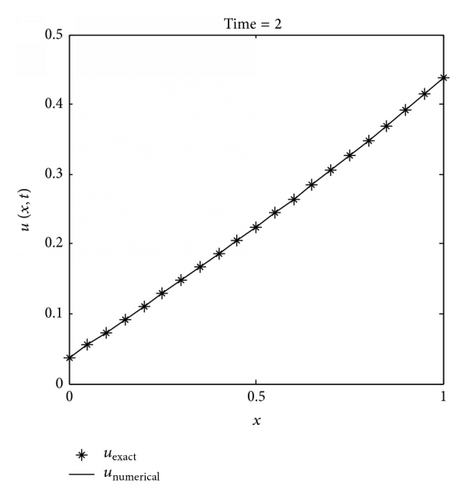
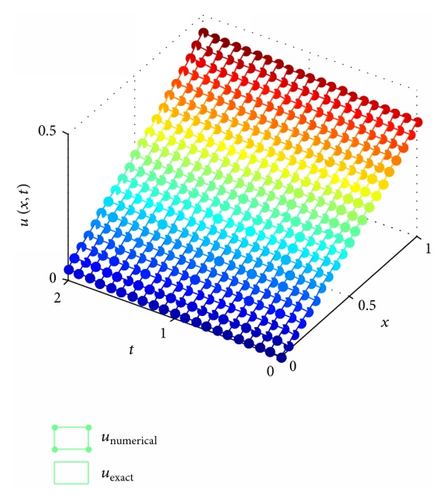
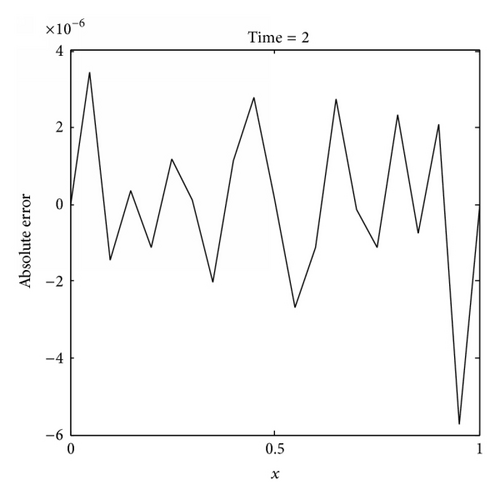
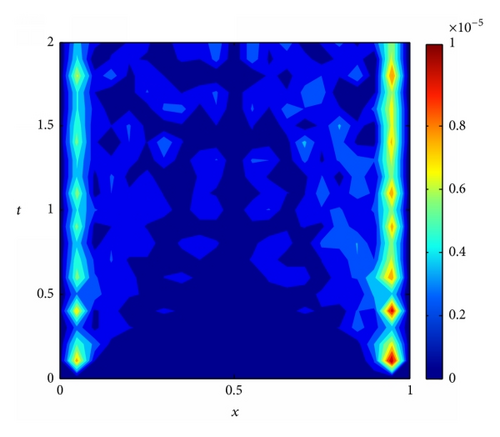
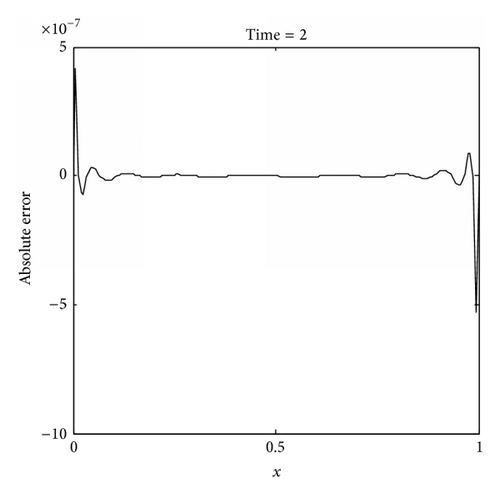
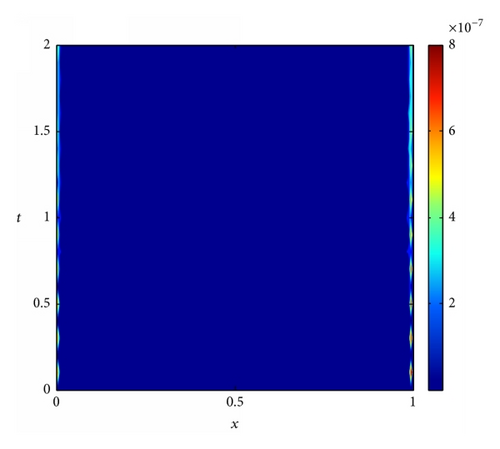
5. Conclusion
In this paper, an element-free IMLS-Ritz method and its numerical implementation on three examples of nonlinear KG equation have been presented. The effectiveness and efficiency of the IMLS-Ritz method for KG equation have been testified through convergence and comparison studies. From the numerical results, it is concluded that the agreement of the IMLS-Ritz solutions with the exact results is excellent. Due to difficulties of constructing analytical solutions for many nonlinear PDEs, the element-free IMLS-Ritz method will have great advantages for solving them through simple implementation with high accuracy.
Conflict of Interests
The authors declare that there is no conflict of interests regarding the publication of this paper.
Acknowledgments
The work described in this paper was partly supported by the National Natural Science Foundation of China (Grant no. 61272098 and Grant no. 11402142), Open Research Fund Program for State Key Laboratory of Estuarine and Coastal Research (SKLEC201207), and Open Research Fund Program for Shandong Province Key Laboratory of Marine Ecology Environment and Disaster Prevention (2012011).



